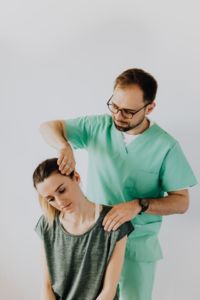Before the age of computers and smartphones, most injuries were caused by active lifestyles. Athletes and people who made their living swinging a hammer or lifting railroad ties were at risk for torn rotator cuffs, back strain, and knee pain. These groups still commonly experience orthopedic injuries, but now a whole new demographic is sharing their pain.
Look around anywhere you go, and you’re sure to see people of all ages hunched over their smartphones. Many of us use computers and tablets at work or school and then spend even more time in front of our devices at home, often while slouched on the couch. Healthcare professionals are seeing more people than ever complaining of stiff necks and backs, chronic headaches, and sore thumbs.
Here are the most common device-related injuries and how you can prevent and treat them:
Carpal Tunnel and Other Repetitive Use Injuries
Carpal Tunnel Syndrome has been increasingly common ever since more of us began typing. It is defined as numbness and tingling in the hand and arm caused by a pinched nerve in the wrist. This nerve can get pinched from repetitive actions like typing when proper form is not used.
Think back to your typing lessons in elementary school; remember being told to arch your wrists while you type? Here’s the real question: how often do you use that form while typing? Typing regularly without using the proper form can cause inflammation in the wrist, this puts pressure on the median nerve and can lead to Carpal Tunnel symptoms. Typing isn’t the only lifestyle-related cause. Any job that requires repetitive movements of the hand or wrist can potentially lead to Carpal Tunnel Syndrome.
The phrase “repetitive use injury” refers to any injury caused by overworking a specific part of the body. Carpal Tunnel is one kind of repetitive use injury; others include Tennis Elbow, Golfer’s Elbow, and rotator cuff pain. These sorts of injuries are common in athletes and those who have physically demanding jobs. Recently another type of repetitive use injury has come on the scene– texting thumb. This injury is caused by the improper use of smartphones and tablets. There are dozens of ways to hold these devices that can injure your body. Common symptoms of smartphone-related injuries include pain near the base of the thumb, wrist pain, and forearm pain.
When using a computer, ergonomic keyboards and wrist supports can help mitigate damage to our hands and wrists, but these adaptations aren’t available for smartphones and tablets. So how do you hold your phone correctly? Start by keeping your wrist as straight as possible. Holding your phone at the sides and texting with both thumbs puts a strain on the wrists, as does holding it in one hand and using your thumb to type or scroll. Placing your phone on a flat surface and using your forefinger to type or scroll is best. You can also hold the phone in one hand and use the other to navigate the screen. Try not to use the same finger all the time. Switch off, and avoid using the thumb. Keep your elbow position in mind. Over bending your elbows can reduce blood flow to your hands and wrists, making them more prone to pain and stiffness.
Neck and Back Pain
You know you should sit up straight while using your computer, but what about while you’re scrolling through social media on your iPad or phone? Many people tend to look downward, bending their neck and back at an unnatural angle. Even a 15-degree tilt of your neck adds 27 pounds of pressure to your spine. Most smartphone users bend their neck further than 15 degrees and can be adding up to 60 pounds of pressure to their spines. This pressure can cause muscle strain and lead to pain and tightness.
To avoid this, bring your device up to eye level. If you have to look downward, use your eyes instead of bending your neck. Check-in with yourself while using your device and straighten your back and neck; try to sit in the same position you would use while on the computer, back straight, screen in front of you. Limiting your device use to 20-minute sessions can reduce muscle strain and have other benefits like lowering stress. If you must use your device for a longer period of time, take micro-breaks to stretch and move around.
Signs you’ve been hunching over your device too much include pain and stiffness in the neck, shoulders, and upper back, headaches, and nerve symptoms like tingling or shooting pain down your arms.
Treating Device-Related Injuries
If you are suffering from pain and stiffness caused by the use of your devices, there are some things you can do to help your body heal. First, take the steps outlined above to avoid worsening your injury. Then seek help from a licensed chiropractor.
Chiropractic adjustment can help to realign the spine and increase the range of movement in injured joints. This is just one tool that can help heal repetitive use injuries and neck and back pain. Here at All Star Chiropractic, we provide holistic help for these problems by showing you how to correct your posture, teaching you corrective exercises and stretches you can do at home, and providing cutting-edge services like cold laser therapy.
Cold laser therapy is a pain-free, non-invasive treatment that reduces inflammation, increases blood flow, and promotes faster healing at the injury site. Cold lasers are perfect for treating injuries to tendons, ligaments, and other soft tissues that are often slow to heal.





